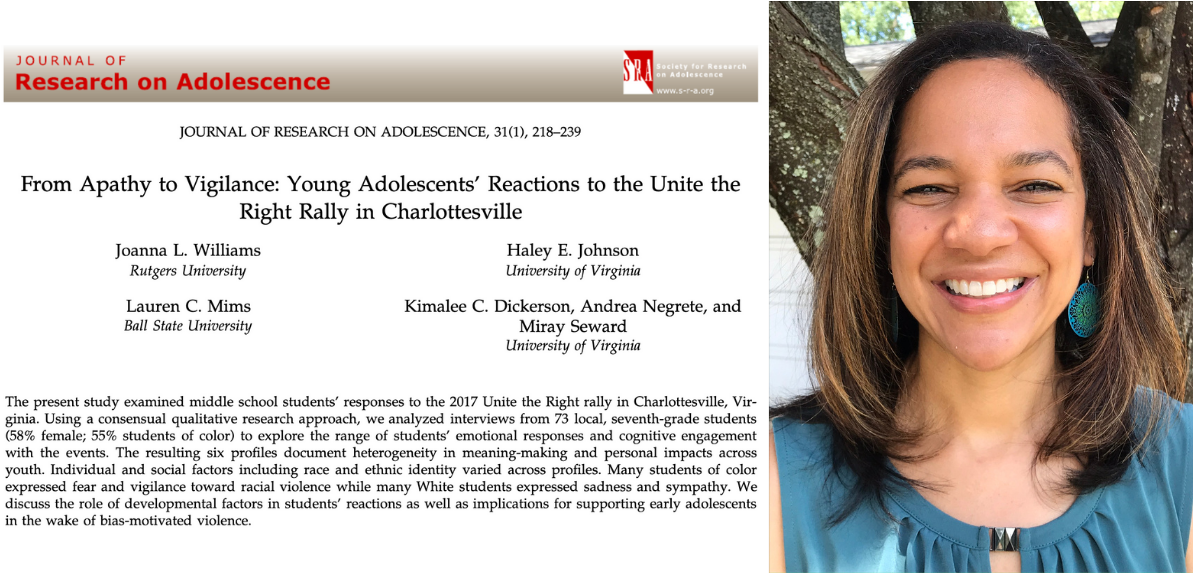Highlights:
- Recent 2021 opinions from the Virginia Supreme Court have allowed the City of Charlottesville to consider acting on Confederate monument removal.
- These statues have been a topic of petitions and rallies since 2016, including the deadly Unite the Right Rally in August of 2017.
- New research sheds light on how adolescents were making sense of the rally and events that unfolded within their community in 2017.

In the spring of 2016, Zyahna Bryant, a 15-year old high school student at the time, wrote a petition to City Council calling for the removal of the Confederate statue of Robert E. Lee and the renaming of Market Street Park (then still named Lee Park) in downtown Charlottesville. Although the park has changed name twice (first to Emancipation Park, and then to its current name, Market Street Park), the statue remains in place despite calls for and multiple attempts at its removal.
In addition to being home to the statue, Market Street Park was the main site of the 2017 Unite the Right rally where members of white supremacist and affiliated groups gathered to protest the statue’s removal. At the time, this was one of the largest and most violent U.S. gatherings in decades.
In April 2021, the Supreme Court of Virginia issued an opinion to reverse previous circuit court rulings that had prevented the removal of the Robert E. Lee statue. As the City of Charlottesville starts a process to act on the monument removal, Youth-Nex is revisiting new research findings about adolescents’ perceptions of the Unite the Right rally that occurred in their own town, during the summer of their middle school years.
Dr. Joanna Williams, a Youth-Nex faculty affiliate, was interviewed by Kalee De France and the Society for Research on Adolescence (SRA) to explain this unique and important research of how young adolescents were making sense of the events that unfolded within their community.
Question: What, in your opinion, is the main takeaway of the article?
Williams: I’ll start by saying there’s like a lot of context to this paper. All of the authors were living in Charlottesville in 2017 when the Unite the Right rally happened. We were about to start year two of a mixed-methods project that was focused on investigating diversity and social relationships in early adolescence. The Unite the Right rally happened in August of 2017, about two weeks before the school year started and, because of the focus of our project, we decided to ask students about their understanding of what had happened.
One of the key takeaways is that we should expect heterogeneity in how youth process events like this. There was a lot of heterogeneity in how kids interpreted and were responding to the Rally. One group of students said things along the lines of “Yeah, I know what happened, but it’s not really on my radar.” A second group knew a lot of the details of what happened but didn’t feel personally impacted – they sounded like news reporters in their accounts.
Another group of students had spent a lot of time processing and talking about what happened. And for some of them, their processing led to disillusionment, like “I can’t believe that stuff like this still happens” or “I thought we were beyond racism”.
There was a fourth group who were feeling, either at the time or a few months later, a sense of fear and vigilance. They said things along the lines of “We know why the KKK was here, and I’m Black. And I know that they were here because of people like me”. These students shared feelings of anger, fear, or just general concern. And, finally, there was a smaller subset of students who were sort of dismissive—they felt like people were overreacting to the situation. They said things like “I’m embarrassed to live in Charlottesville because we’re getting so much attention because of things like this”
The second type of heterogeneity that we saw was in relation to who belonged to these groups. On one hand, the group of students who expressed fear and vigilance were all students of color and most identified as Black. On the other hand, there were also many Black and other students of color who did not express any personal stress or concern, but there were White students in this group as well. White students made up the bulk of students who sounded like reporters or who expressed disillusionment or sympathy. The small group of dismissive students all identified as White.
It’s important to make sense of this heterogeneity in the context of what we know about young adolescents: they’re making meaning of important and abstract concepts, like racism and white supremacy while also trying to make sense of their own identities.
For more from this Q&A including the experiences of Dr. Williams’ team when asking these tough questions and what she is looking forward to seeing in upcoming research, please see the SRA blog. For more on these research findings, please see the Journal for Research on Adolescence article entitled “From Apathy to Vigilance: Young Adolescents’ Reactions to the Unite the Right Rally in Charlottesville.”
If you have any comments or questions about this post, please email Youth-Nex@virginia.edu. Please visit the Youth-Nex Homepage for up to date information about the work happening at the center.
